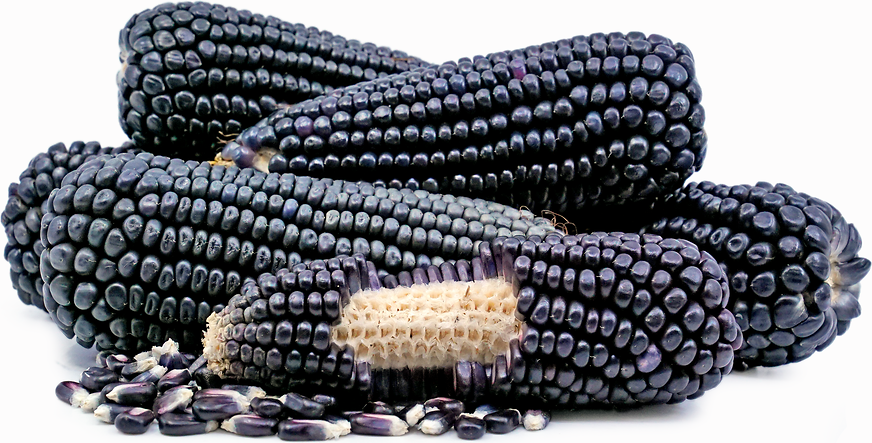


Black Corn
Estimated Inventory, ea : 0
Description/Taste
Black corn is distinguished by its dark, glossy kernels and firm structure. It is generally a medium-sized corn variety, each cob measuring about 15 to 30 centimeters long, but may vary depending on the variety of Black corn. The cob has an elongated shape, with one end rounded and the other more pointed. Its color may be white when young but eventually develops a dark black-indigo hue that may contain lighter purple pigments throughout its body. Each cob consists of multiple rows of kernels that are mostly uniform but may slightly curve from one ear to the other. The kernels are initially hard and firm but become softer and more succulent when cooked. When all these kernels are removed, an off-white cob with a solid core remains. This cob has a grid-like pattern with square inserts and a flimsy, translucent skin big enough to fit each kernel. The chewy, starchy texture of Black corn is complemented by a sweetness that is milder than that of yellow corn.
Seasons/Availability
Black corn is available during the summer.
Current Facts
Black corn is botanically classified as Zea mais and belongs to the Poaceae family, which also includes all other varieties of corn as well as barley, millet, oats, and rice. Black corn is a dark-hued variety native to the Andean region of South America. It is labeled as both a grain and a vegetable and goes by many different names throughout the world. In Peru, it’s called Maiz Morado and Kculli. It’s often referred to as Purple, Black Aztec, or Black Mexican corn in the United States and United Kingdom. There are many varieties of Black corn, including Japanese Black Sticky, Dakota Black, and Mountain Morado. This vegetable is valued for having subtle flavor and a unique color, which also makes it popular as an ornamental.
Nutritional Value
Black corn contains anthocyanins, the pigment responsible for its deep color, which provides anti-inflammatory and antioxidant effects, helping to reduce inflammation and protect the body from oxidative stress. Black corn is also a good source of iron, which supports the production of hemoglobin and prevents anemia, while thiamin, riboflavin, and niacin play key roles in energy metabolism, helping the body efficiently convert food into energy. The presence of magnesium aids in muscle and nerve function, while phosphorus is essential for bone health. The folate in Black corn supports cell function and tissue growth, making it crucial during periods of rapid growth, such as pregnancy. The vegetable's vitamin A content contributes to eye health, supports immune function, and promotes healthy skin.
Applications
Black corn cannot be consumed raw but bodes well for grilling, roasting, boiling, and steaming. This variety can be substituted for yellow corn in many recipes and is often cooked on the cob, then topped with butter, salt, and pepper to enhance its flavor. Black corn can also be ground into cornmeal for making cornbread, tortillas, chips, and Indian roti bread. Its tortillas are perfect for tacos, tostadas, taquitos, and breakfast dishes like huevos rancheros. The cooked kernels can be sliced off the cob and used in corn salads, taco bowls, soups, and bean dips. Black corn is also used to make the Peruvian pudding mazamorra morada, which features ingredients like cloves, cinnamon sticks, pineapple, Granny Smith apples, quince, lime, dried apricots, dried cherries, star anise, stevia, and ground cinnamon. Black corn should be stored in the refrigerator with its husks on.
Ethnic/Cultural Info
One of the most popular uses for Black corn is in the traditional drink chicha morada. This Peruvian beverage has a rustic, subtly sweet flavor, blending Black corn with ingredients like cloves, cinnamon sticks, apples, lemons, brown sugar, and pineapple. This fermented drink has been consumed since before the rise of the Incan civilization and is still enjoyed by Peruvians today. Chicha morada was used in ceremonies honoring the dead, particularly during the reign of the Marcavalle, Churajón, Chavín, and Tiwanaku cultures. Numerous archaeological findings of plates and vessels from these ancient peoples confirm that this drink has been consumed for centuries.
Geography/History
The exact origins of Black corn are unclear but it is confirmed to be a variety grown by the Aztecs over 2,000 years ago and has been used since ancient times in areas throughout South America, notably Peru. Black corn made its way into North American seed catalogs in the 1860s, and today, it is still considered a relatively uncommon variety outside of South America. Black corn requires warm temperatures to germinate and grow, thriving in temperate climates with moderate to high rainfall. Outside of South America, Black corn is not commonly found in supermarkets but may be sourced from farmers’ markets on the West Coast and in the Southwest regions of the United States.
Recipe Ideas
Recipes that include Black Corn. One
| Simply |
|
Black Corn Salad |
| Pisco Trail |
|
Chicha Morada Base (Purple Corn Elixir) |
| The Spruce |
|
Mazamorra Morada - Peruvian Purple Corn Pudding |
| A Cozy Kitchen |
|
Peruvian Chicha Morada |

















